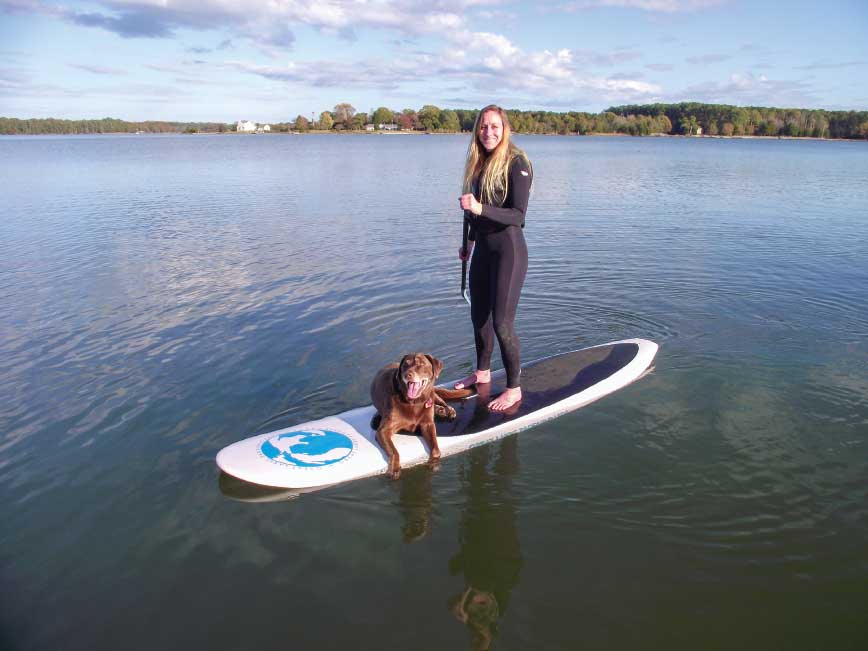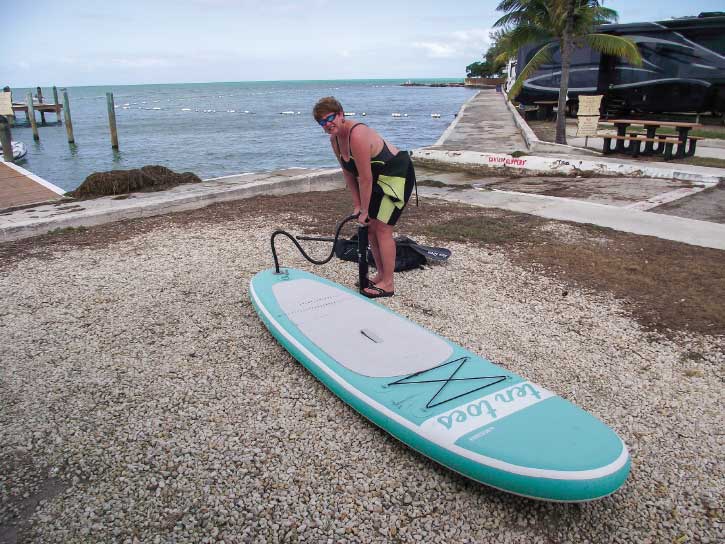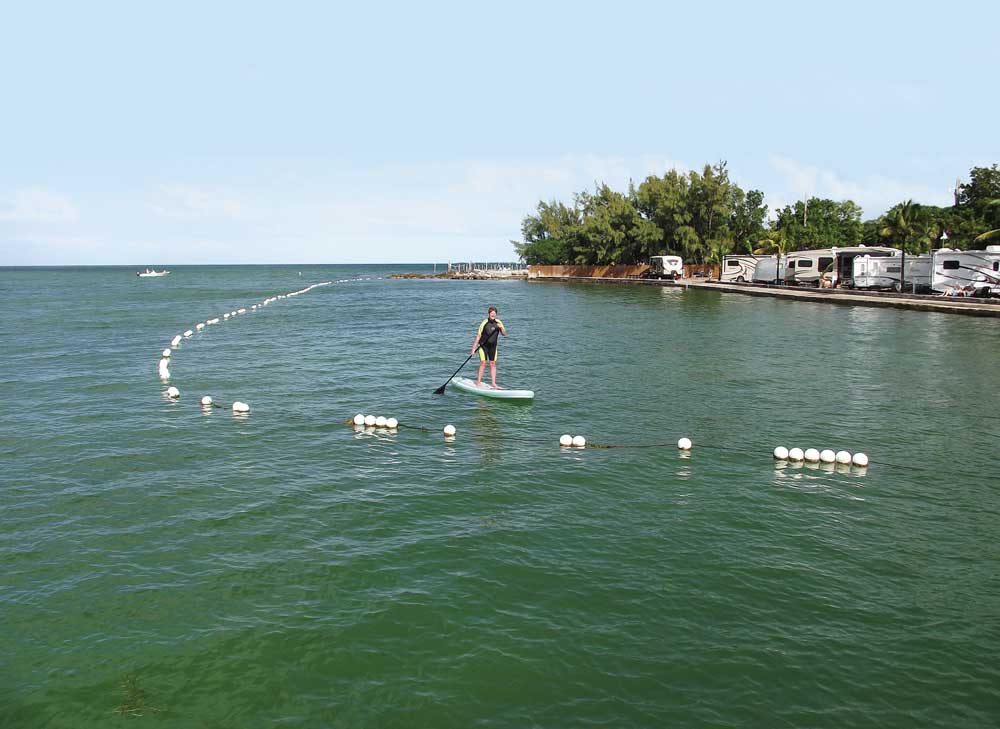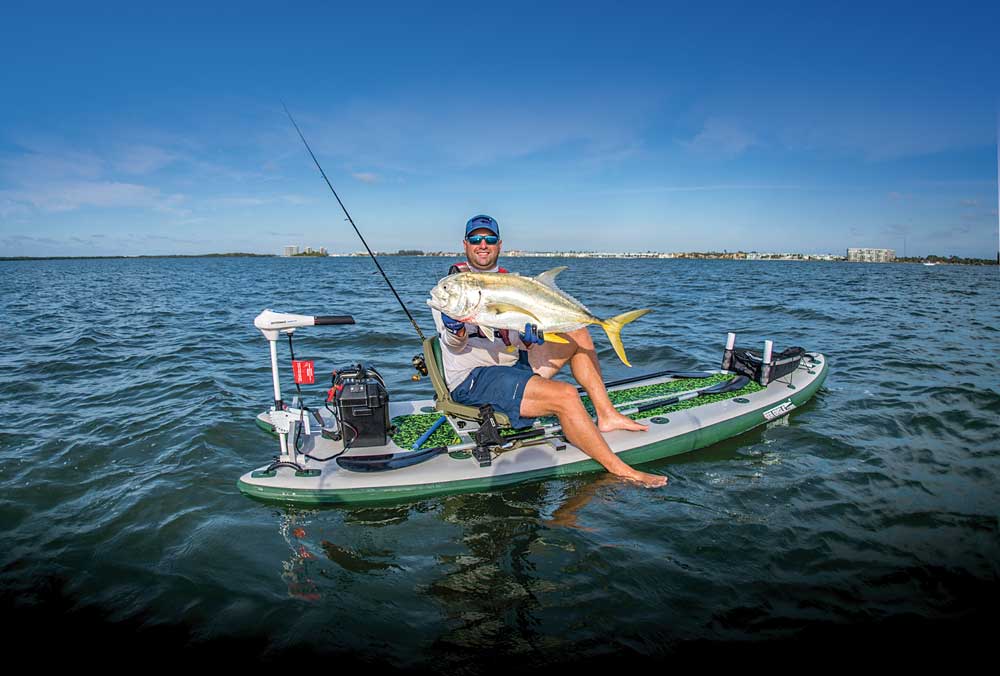A stand-up paddleboard is a great way to get in shape while enjoying the outdoors
We’ve all heard of the “Freshman 15,” the unfortunate weight gain that sometimes accompanies living out of college dorm refrigerators and eating cafeteria food. But you might be more familiar with the “Campground 10” – the extra pounds that result from living life on vacation for weeks, and even months, at a time. My first experience with this malady came in the winter of 2015, when we tried snowbirding in Florida for the first time. From fried plantains and 50-cent shrimp to sunset toasts on the Gulf, it felt like two glorious months of nothing but Saturdays. The problem came when I had to switch from shorts to jeans on the way home. It became immediately clear from the way my clothes fit (or didn’t) that I was in trouble.
The problem wasn’t just food – it was exercise. While many campgrounds provide fitness rooms, who wants to travel hundreds of miles to spend time indoors? Just walking or biking weren’t going to do it. What I needed was a portable exercise machine that could give me a complete workout while still letting me enjoy the great outdoors. I got it all, and more, with a stand-up paddleboard (SUP).

An all-around fiberglass board has enough volume to float a paddler and her pet.
Paddle boarding doesn’t require any special skills, and it is one of the few sports that has proven equally popular among young and old alike. In fact, stand-up paddle boarding is the fastest growing watersport in the United States, with more than 2.8 million participants. Best of all, stand-up paddle boarding isn’t just aerobic exercise – it utilizes a range of muscles, providing a full-body workout. With so many campgrounds along the coasts, rivers and lakes, it is a great exercise option for RVers like me.
“Stand-up paddle boarding works the core. It’s also a great way to sculpt your abs, shoulders, back and hips,” says YMCA fitness trainer and certified paddleboard yoga instructor Rebecca Wojtach.
Wojtach, who leads SUP tours and teaches paddleboard yoga classes at the five-star Tides Inn and Spa in Irvington, Virginia, notes that the sport has the added advantage of getting users outside, enjoying their physical environment in a way that isn’t possible with most other forms of exercise. I agree; in my first year with my own SUP, I’ve seen everything from manatees to mountain waterfalls, all while burning calories, improving balance and toning muscles.
If that sounds better than sweating at the gym, here are some options to consider before adding an SUP to your motorhome’s inventory.
Hard Board or Inflatable?
For RVers, it all comes down to space. The typical paddleboard will be more than 10 feet in length, and there aren’t a lot of dedicated storage spaces in a motorhome that can accommodate objects of that size. If, like many of us, you barely have room for your golf clubs and scuba gear, an inflatable SUP is a great choice. Look for one constructed of multilayered cloth, drop-stitched with an outer shell of military-grade PVC. These inflatable boards are lighter than hard boards but are rugged enough to withstand collisions with rocks and hard surfaces. When properly inflated, they have comparable rigidity to a hard board and are generally less expensive. Their biggest advantage is ease of transport – an inflatable SUP, manual pump and two-piece paddle can fit inside a specially designed backpack and be worn while riding a bike.

Inflatables are lightweight enough to be transported around the campground in an SUP backpack.
If you travel with a toy hauler or have a towed vehicle with an empty roof rack, you might want to look at hard boards. The least expensive option in this category is plastic, which has the added advantage of “bomb proof” durability. You can even attach accessories like fishing rod holders or seats to the deck of a plastic SUP without compromising its structural integrity. On the negative side, these SUPs are heavy and can be unresponsive and hard to paddle. Another option is fiberglass. These boards have a foam core and are light, fast and maneuverable. The downside is that they cost more than plastic boards and are easily “dinged” by rocks, docks and pets. Strapping one tightly to a roof rack can even cause minor damage to the rails and deck. The third and most expensive option is carbon fiber.
These high-performance boards are used primarily for racing and touring, and are among the lightest and most rigid manufactured. (For a selection of motorhomes that do offer extra space for a stand-up paddleboard, turn to page 32.)
Shapes and Sizes
In addition to board material, you have a variety of sizes and shapes to choose from. Most new paddlers will want to look for a touring/cruising or all-around SUP ranging between 10 and 11½ feet. The touring/cruising board is built for glide, with a V-shaped bow designed to cut through the water for better tracking and speed. All-around boards have a more rounded nose and wider body, providing stability for beginners and for bringing pets or small children along for the ride. Most all-around boards are even stable enough to be used for yoga, though there are also dedicated yoga boards available. These often have bottoms shaped specifically to support the user’s balance, a soft top and “bumper” sides, and places to hook on exercise equipment or an anchor.

Inflating a board (here at a campground overlooking the Gulf of Mexico) takes about 10 minutes with a hand pump.
For experienced paddlers and competitive types, a race board is another option. Ranging between 12½ and 20 feet in length, these boards have a long, narrow profile and pointed nose for excellent tracking ability at high speeds. They are also less stable and extremely responsive to paddler movement, requiring more skill, and are generally much more expensive than other types of boards.
If you’d like to take your SUP in the surf or on whitewater, look at wave boards. These are usually less than 10 feet long with a narrow nose and tail for quick turning. They are lightweight and low volume, meaning they will be less stable. They also don’t track well over distance so they do not easily transition to touring/cruising.
After narrowing down the type of board you want, arrange to rent or demo boards from different manufacturers. Small differences in bottom shape, rails and fin configurations can make big differences on the water. Before you buy, also look closely at the volume or displacement and the suggested weight limits by asking for the specs or checking the manufacturer’s website. For beginners, bigger is better –especially if you don’t want to get wet.

It’s a good idea to try out the board in calm, shallow water like this swimming area.
Getting on the Water
An SUP is considered a vessel by the U.S. Coast Guard unless operated in surf or a designated swimming area, so in most states you are required to have a life jacket and signaling device, such as a whistle, on board. A personal flotation device (PFD) specifically designed for paddlers, like a self-inflating SUP belt-style life jacket, will provide the greatest flexibility of movement, but for those who have health issues or are not confident swimmers, a vest-style Type III PFD is a better choice. The majority of accidents occur when paddlers get separated from their boards, so experts recommend wearing a leash in addition to a life jacket, especially in rough water. For your first time, you might also want to sign up for a lesson or an SUP tour. While paddle boarding is not hard, an instructor can show you a few tricks to make balancing, turning, and stopping safer and easier. Then you’ll be ready to banish the “Campground 10” forever.
Sea Eagle SUPs

All Sea Eagle inflatable SUPS are constructed of 1,000-denier reinforced drop-stitch material for improved rigidity and durability, and all come complete with a unique paddle pocket for stowing the paddle. Basic LongBoard and NeedleNose packages come complete with hull, paddle, removable skeg, hand pump, backpack, and repair kit, and current MSRPs start at $699 for the LB11 and $899 for the NN116. The basic FishSUP package includes hull, both SUP and sitting paddles, backpack, seat, storage box, backpack, hand and foot pumps, and repair kit for $879.
Sea Eagle Boats, 800-748-8066, www.seaeagle.com
If an inflatable board is the best fit for your RV lifestyle, Sea Eagle is the place to start. Known for its innovative boards as well as for its customer service, the company is one of the largest manufacturers of economically priced inflatables worldwide. Sea Eagle offers three series of SUPs, each tailored to specific situations and water conditions, to provide users with the highest performance at an affordable price.
LongBoard Series

An all-around or hybrid board, these inflatables allow users to sit, stand, surf, fish, tour and even perform yoga. Designed for stability, Sea Eagle LongBoards are 30 inches wide and 6 inches thick, providing plenty of flotation, and unlike many all-around boards, the Stand Up/Sit Down LongBoard has been updated with premium paddling performance in mind. A newly added 4-inch nose/entry rocker, followed by a slight continuous board rocker and 2-inch tail rocker add up to improved handling, and the full-length EVA foam Diamond Deck Pad provides traction and comfort. These qualities make the LongBoard perfect for surfing and extended touring. Available in 11-foot length for riders up to 200 pounds and 12½-foot length for riders up to 250 pounds.
NeedleNose Series

These high-performance boards offer all the benefits of a rigid SUP with the convenience of an inflatable. The unique, patented design features a sharp, wave-piercing bow, allowing users to slice cleanly through rough water. The sleek touring shape, skeg (tapered stern) design and kick tail maximize tracking and handling and, best of all, each board in this series weighs less than 30 pounds. The touring models are available in 11-foot 6-inch, 12-foot 6-inch, and 14-foot lengths, with two leading side skegs and a removable rear fin, and all feature the same comfortable width and foam deck of the LongBoard Series. Sea Eagle also makes the 126 R, a racing model weighing in at only 23 pounds, with a narrower waist (26 inches) and a single fin for increased speed.
The FishSUP

Sea Eagle’s Fishing Inflatable SUP is unlike anything else on the market. Wide and stable, this board has all the benefits of an inflatable kayak while still providing the fun and versatility of an SUP. It features 14 D-ring attachment points for adding accessories and gear, and a removable rear motor mount that can handle up to a 55-pound thrust electric trolling motor. The nonskid EVA foam camo deck is great for standing or sitting, and the FishSUP even includes a built-in 36-inch fish ruler. This inflatable is rated for up to 350 pounds, so you can even bring along the family dog. The design is perfect for families who want a multiuse SUP that can be easily stowed in an RV’s limited storage space.
SUP MSRPs
Plastic stand-up paddleboards like the Lifetime Freestyle and Sea Quest 10 start at as little as $349, while fiberglass boards range from an MSRP of $700 to $2,000. Inflatables, like the Ten Toes Weekender, pictured on the following page, start at about $600.

